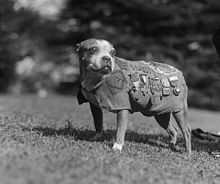Sergeant Stubby
| Sergeant Stubby | |
|---|---|
 Sergeant Stubby | |
| Born | 1916 or 1917. |
| Died | April 4, 1926 (aged 9–10) |
| Place of display | Smithsonian - "The Price of Freedom" exhibition |
| Allegiance | United States of America |
| Service/branch | United States Army |
| Rank | Sergeant |
| Unit | 102nd Infantry, 26th (Yankee) Division |
| Battles/wars | World War I |
| Awards |
Humane Education Society Gold Medal Medal of Honor Wound stripe |
| Other work | Hoyas' mascot |
Sergeant Stubby (1916 or 1917 – April 4, 1926), was the most decorated war dog of World War I and the only dog to be promoted to sergeant through combat. America's first war dog, Stubby served for 18 months and participated in seventeen battles on the Western Front. He saved his regiment from surprise mustard gas attacks, found and comforted the wounded, and even once caught a German spy by the seat of his pants, holding him there until American soldiers found him. Back home his exploits were front page news of every major newspaper.
Early life
Stubby, according to vintage articles from his time,[1] was noted to be a Pit Bull breed.[2][3][4] Stubby was found wandering the grounds of Yale university campus in New Haven, Connecticut while a group of soldiers were training. The dog hung around as the men drilled and one soldier, Corporal Robert Conroy, developed a fondness for the Pit Bull. When it came time for the outfit to ship out, Conroy hid Stubby on board the troop ship. The story goes that upon discovery by Conroy's commanding officer, Stubby saluted him as he had been trained to in camp, and the commanding officer was so impressed that he allowed the dog to stay on board.
Military service

Stubby served with the 102nd Infantry, 26th (Yankee) Division in the trenches in France for 18 months and participated in four offensives and 17 battles. He entered combat on February 5, 1918 at Chemin des Dames, north of Soissons, and was under constant fire, day and night for over a month. In April 1918, during a raid to take Schieprey, Stubby was wounded in the foreleg by the retreating Germans throwing hand grenades. He was sent to the rear for convalescence, and as he had done on the front was able to improve morale. When he recovered from his wounds, Stubby returned to the trenches.
After being gassed himself, Stubby learned to warn his unit of poison gas attacks, located wounded soldiers in no man's land, and — since he could hear the whine of incoming artillery shells before humans could — became very adept at letting his unit know when to duck for cover. He was solely responsible for capturing a German spy in the Argonne. Following the retaking of Château-Thierry by the US, the women of the town made Stubby a chamois coat on which were pinned his many medals. He also helped free a French town from the Germans. He was later injured in the chest and leg by a grenade. At the end of the war, Conroy smuggled Stubby home. [5]
After the war

After returning home, Stubby became a celebrity and marched in, and normally led, many parades across the country. He met Presidents Woodrow Wilson, Calvin Coolidge, and Warren G. Harding. Starting in 1921, he attended Georgetown University Law Center with Conroy, and became the Georgetown Hoyas' team mascot.[6]
Medals and Awards
- 3 Service Stripes
- Yankee Division YD Patch
- French Medal Battle of Verdun
- 1st Annual American Legion Convention Medal
- New Haven World War I Veterans Medal
- Republic of France Grande War Medal
- St Mihiel Campaign Medal
- Wound stripe, replaced with Purple Heart when introduced in 1932
- Chateau Thierry Campaign Medal
- 6th Annual American Legion Convention
- Humane Education Society Gold Medal
Stubby was also featured in the Brave Beasts exhibit at the Legermuseum in Delft, The Netherlands.[7]
See also
- Cher Ami – Carrier pigeon who is displayed with Stubby in the Smithsonian Institution's Americans at War: The Price of Freedom exhibit.
- List of individual dogs
- Military animal
References
- ↑ "Evening public ledger. (Philadelphia [Pa.]) 1914-1942, July 09, 1921, NIGHT EXTRA, Image 18 « Chronicling America « Library of Congress". Chroniclingamerica.loc.gov. 1921-07-09. Retrieved 2013-12-06.
- ↑ http://chroniclingamerica.loc.gov/lccn/sn85042462/1910-01-02/ed-1/seq-49.pdf
- ↑ http://chroniclingamerica.loc.gov/lccn/sn85066387/1911-08-20/ed-1/seq-14.pdf
- ↑ http://i.imgur.com/A43lk3v.jpg
- ↑ "The Price of Freedom: Exhibition". Amhistory.si.edu. Retrieved 2013-08-11.
- ↑ http://www.ct.gov/mil/cwp/view.asp?a=1351&q=257892
- ↑ "Brave Beasts". Legermuseum. July 18, 2008. Retrieved December 21, 2009.
- Richmond, Derek (November 4, 2003). From Mascot to Military, Stubby Left Pawprints on Hilltop and Beyond. Georgetown, Washington, D.C: The Hoya of Georgetown University.
- "The Price of Freedom: Americans at War – Stubby". Smithsonian Institution.
- "Stubby the Military Dog". Connecticut Military Department. July 16, 2003. Retrieved March 26, 2010.
- "Stubby, World War I Canine Hero 1921". History Wired. Smithsonian Institution.
- Irwin, Tanya (May 27, 2013). "Canine soldiers earn accolades: Exhibit extols virtues of WWI’s Sgt. Stubby". Toledo, Ohio: Toledo Blade.
- "1921 The Evening World: Stubby, a brindle Boston Bull Terrier...". Chroniclingamerica.loc.gov.
- "Vintage Boston Terrier name "Boston Bull Terrier" (in reference to Stubby's breed)". Chroniclingamerica.loc.gov.
- "Visual of the Boston Terrier (aka Boston Bull Terrier) of 1912". I.imgur.com.
External links
| Wikimedia Commons has media related to Sergeant Stubby. |